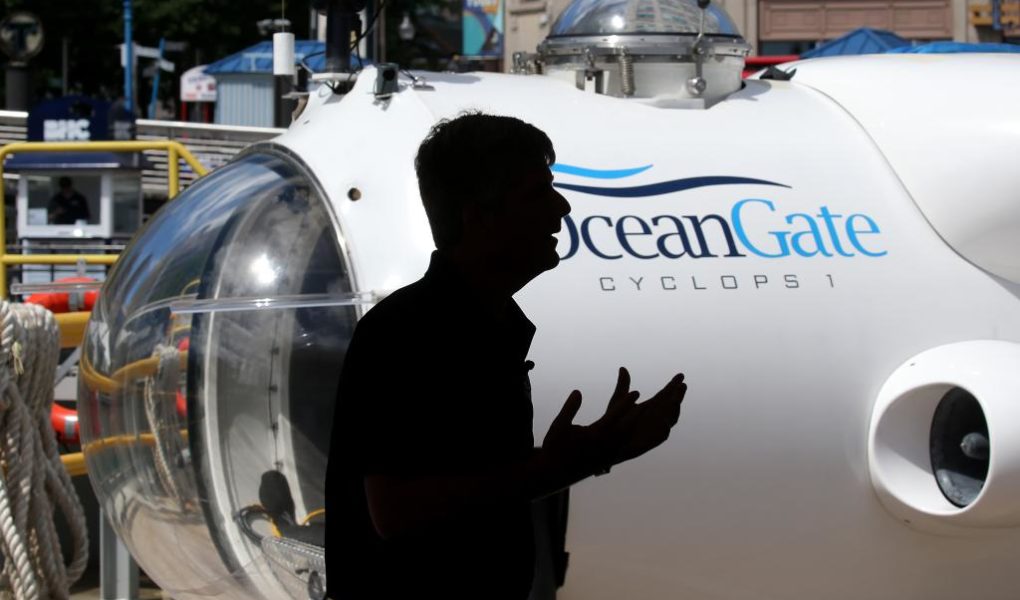OceanGate Expeditions is the owner and operator behind the Titan submersible, which had five people on board when it experienced what the Coast Guard called a “catastrophic implosion” amid its journey to the Titanic shipwreck.
The privately-owned US company was founded in Everett, Wash., in 2009 by Guillermo Söhnlein and Stockton Rush to build out a fleet of three five-person submersibles that would be used to take tourists down to the famed wreck.
Söhnlein left OceanGate 10 years ago, though Rush continued on as the company’s CEO, developing three submersibles named Antipodes, Cyclops 1 and Titan.
OceanGate’s Titanic expedition is billed on its website as an eight-day trip that provides a “chance to step outside of everyday life and discover something truly extraordinary.”
Up to four of those days could be spent underwater. OceanGate assured on its site that the 22-foot vessel was equipped with up to 96 hours of oxygen.
Tickets run for $250,000, and travelers must be at least 17 years old, the site adds.
The trip departs from St. John’s Newfoundland, Canada, before sailing 380 miles offshore and diving 12,500 feet below the surface to the Titanic.
The Titan’s latest expedition, which began its descent to the sea floor on June 18, was the only OceanGate Titanic tour slated to take place in 2023, which passenger Hamish Harding cited was due to weather in an Instagram post ahead of his departure.

Titan weighed 21,000 pounds and could travel at the speed of 3 knots, or 3.5 miles per hour. It had a single porthole for up to two people to look out of at any time.
The passengers included 61-year-old OceanGate boss, Rush, as well as Titanic specialist Paul-Henri Nargeolet, UK billionaire explorer Hamish Harding and Pakistani billionaire and mogul Shanzada Dawood and his 19-year-old son, Sulaiman.
Here’s everything else you need to know about the vessel.
What’s next for OceanGate?
Legal experts are divided as to whether OceanGate faces legal liability over the Titan disaster given that the passengers all signed waivers that spelled out the risk to their safety.
One lawyer thinks that the next of kin will have an uphill legal battle in court if they decide to sue OceanGate despite past allegations of negligence and the most recent tragedy.
“The chance of family members of the passengers having a successful lawsuit against the company is close to zero,” attorney Sherif Edmond El Dabe, a partner with El Dabe Ritter Trial Lawyers, told Insider.
“The passengers knowingly participated in an extremely hazardous activity and they knowingly assumed great risk,” he added.
Miguel Custodio, an attorney at the law firm Custodio and Dubey LLP, agreed, telling the outlet: “Everyone on board knew this wasn’t a vacation or a sightseeing trip, and the disclaimer appears to have made the risk of death very clear multiple times.”

It’s all thanks to an ironclad, three-page document that spells out the risks for Titan passengers that includes an eye-popping admission that the craft “has not been approved or certified by any regulatory body and may be constructed of materials that have not been widely used on human occupied submersible.”
The document, which was provided to a passenger last summer, also states that the signer would “assume full responsibility for the risk of bodily injury, disability, death and property damage due to the negligence of [OceanGate] while involved in the operation,” according to TMZ, which was first to publish it.
The company also provided a litany of worst-case scenarios in covering itself from liability, including possible exposure to high-pressure gases, high-voltage electrical systems and “other dangers” that could lead to disability, injury or death.
Other experts, however, said that the waivers do not shield the company from legal action.
If OceanGate expeditions is found to have engaged in “gross negligence,” which is defined as wanton or reckless conduct affecting the life of another, it could make the company vulnerable to lawsuits.
Michael Sturley, a professor of maritime law at the University of Texas, told Bloomberg News that the families of those who perished could still sue.
Sturley cited a letter from William Kohnen, chairman of the Marine Technology Society’s manned submersibles committee, addressed to Stockton Rush, the OceanGate CEO, warning him that he was misleading the public with false claims that the Titan met industry safety standards.
Rush made several comments about safety regulations in the years leading up to the Titan disaster. He criticized industry safety standards as “illogical” and lamented that they were stifling innovation. Last year, he told CBS reporter David Pogue that “at some point, safety is just pure waste.”
These comments and Sturley’s letter could be used as evidence in a lawsuit brought by the families of the deceased, according to Sturley.
“It shows that the company was on notice that the unanimous view of other people in the industry was that they should be doing things that they apparently weren’t doing,” Sturley said.

Will OceanGate go out of business?
It’s unclear if OceanGate will cease operations after Titan’s tragic implosion.
Söhnlein, OceanGate’s co-founder who’s now a minority shareholder, said on Friday that the company’s executives “will be considering the company’s survival,” according to Forbes.
He said the board of directors will weigh in on OceanGate’s fate for the next several weeks, the outlet reported.
Certain landing pages of OceanGate’s website went offline after it announced the loss of Titan.
Meanwhile, OceanGate is also unlikely to foot the bill for the rescue mission that was launched to find the missing Titan submersible — and the operation is expected to cost millions of dollars, according to experts.
Ret. Adm. Paul Zukunft, who commanded the Coast Guard from 2014 to 2018, told The Washington Post that “it’s no different than if a private citizen goes out and his boat sinks.”
“We go out and recover him. We don’t stick them with the bill after the fact.”
Deep-sea robots will continue searching the sea floor for clues about what happened deep in the North Atlantic.

How many successful missions has Titan done?
OceanGate Expeditions started offering trips to the wreckage site of the Titanic in 2021. Since that time, the Titan submersible made just two successful voyages to the Atlantic Ocean seabed where the Titanic lay.
The ill-fated mission that ended in tragedy this week was just the third such trip.
Arthur Loibl, 60, a German adventurer, took the maiden voyage in the Titan submersible in August 2021. He told the German news outlet Bild that the trip was a “suicide mission” from which he was lucky to escape alive.
“I was incredibly lucky back then,” Loibl told Bild.
Loibl paid nearly $110,000 to dive down more than 12,000 feet to the wreckage site. He said that the mission ended up being launched five hours late due to electrical issues.
Loibl also said that a 1,600-meter dive by the submersible had to be “abandoned.” When the bracket of the stabilization tube ripped, it had to be “reattached with zip ties,” he said.
When asked to describe the voyage, Loibl said: “You need strong nerves, you mustn’t be claustrophobic and you have to be able to sit cross-legged for ten hours.”
Loibl was joined by French Titanic expert Paul-Henry Nargeolet, 73, and Stockton Rush, the 61-year-old CEO of OceanGate Expeditions.
Nargeolet, Rush, British businessman Hamish Harding, and Pakistani magnate Shahzada Dawood and his son, Suleman, died in what authorities called a “catastrophic implosion” which destroyed the Titan this week.

How Titan launched
OceanGate Expedition’s Titan submersible is a 9-foot-high, 8-foot-wide, 22-foot-long vessel weighing 25,000 pounds.
The vehicle, which is designed to take tourists deep underwater, differs from a submarine, which is autonomous and self-powered.
The Titan, on the other hand, is a submersible, meaning that it is launched underwater from a platform that can be carried out to sea aboard a mother ship that can recover it.
The submersible is then submerged a few dozen feet below the surface of the ocean.
A submersible has limited power reserves. Its electric thrusters enable it to travel at a speed of 3 knots, or 3.5 miles per hour.
OceanGate said it was equipped with LED lights, a sonar navigation system, and high-end camera equipment as well as a life-support system that can keep five people alive for up to 96 hours.
OceanGate workers on the surface ship track the location of Titan and send text messages to the pilot with navigation instructions.
The Titan and its support ship left the port of St. John’s in Newfoundland, Canada last Friday.
The Canadian support ship which monitored the Titan lost contact with the submersible about an hour and 45 minutes later after arriving at the wreckage site of the Titanic on Sunday.
The submersible’s last known position was near the Titanic, whose remains lie some 370 miles southeast of the Newfoundland coast.

OceanGate’s submersibles
OceanGate’s crown jewel was Antipodes, which it acquired in 2009.
According to a brochure on the company’s site, Antipodes could travel up to 1,000 feet underwater, had capacity for five people and could carry up to 72 hours of life support.
OceanGate purchased a second five-person submersible in 2012, which was reconstructed into Cyclops 1 — a 20,000-pound vessel that could carry up to 80 hours of life support.
While it served as a working prototype for Titan, Cyclops 1 would only travel to depths of 1,640 feet, while Titan was designed to explore beyond depths of 13,000 feet, where the Titanic wreck lies.
Titan is OceanGate’s newest submersible. The vessel was constructed out of carbon fiber and titanium, and was equipped with 96 hours of oxygen.
However, it also contained some other off-the-shelf components, including scaffolding poles for the sub’s ballast and a video game controller in place of a steering wheel.
Specifically, a modified Logitech F710 wireless controller was used to operate Titan.
𝗖𝗿𝗲𝗱𝗶𝘁𝘀, 𝗖𝗼𝗽𝘆𝗿𝗶𝗴𝗵𝘁 & 𝗖𝗼𝘂𝗿𝘁𝗲𝘀𝘆: nypost.com
𝗙𝗼𝗿 𝗮𝗻𝘆 𝗰𝗼𝗺𝗽𝗹𝗮𝗶𝗻𝘁𝘀 𝗿𝗲𝗴𝗮𝗿𝗱𝗶𝗻𝗴 𝗗𝗠𝗖𝗔,
𝗣𝗹𝗲𝗮𝘀𝗲 𝘀𝗲𝗻𝗱 𝘂𝘀 𝗮𝗻 𝗲𝗺𝗮𝗶𝗹 𝗮𝘁 dmca@enspirers.com




